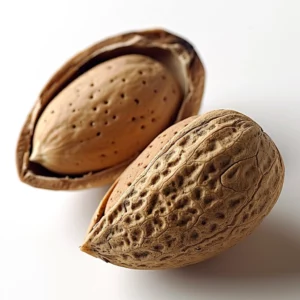Ready for an edible adventure marked with a splash of Mediterranean delight? Buckle your gardening gloves and arm yourself with patience, for we’re about to venture into the world of almond trees. Often overshadowed by other popular home garden trees, almond trees can be a beautiful addition to your green space, not just for their nuts but also for the visual fiesta they offer – rivalling even the cherry blossoms. With a bit of know-how and a zest for horticultural joy, you can soon be harvesting your very own almonds.
The Tale of Almonds
Unlike their cherry blossom competitors, the almond tree’s tale starts with a story of durability. Ancients across the Mediterranean and Middle East revered almonds for their versatility and long lifespan. In Roman times, newlyweds were showered with the blossoms as a fertility charm—a tradition that seems more relevant than ever as we look to grow and nurture from the earth’s bounty.

Step 1: Prepping for Planting
Before you plunge into the earth, it’s vital to choose the right variety. Self-fertile trees like the ‘All-in-One’ are perfect if you’re short on space. If acreage is your ally, consider the classic ‘Nonpareil’ with its early-season blooms. Ensure your garden offers full sunlight, well-draining soil, and enough room for the tree to grow—almonds can reach 15 to 30 feet in height.
Step 2: It’s Growing Time!
Now it’s time to plant. Begin in early spring, once the threat of frost has passed. Dig a hole that’s twice as wide and deep as your tree’s root ball. Place the roots gently, backfill with soil, and give it a good drink. Almonds love water, but not waterlogged conditions, so be sure to institute a schedule that keeps the soil moist but not soggy.
Step 3: Growing Pains and Pleasures
Those first few years are the trees’ adolescence. Prune each year to encourage a strong frame and drive for the sky. And don’t just dream of nuts yet; for the first 3-5 years, this tenacious tree likely won’t produce. But that’s the thing about gardening—it gifts you patience!
Step 4: Nurturing Nuttiness
Almonds are heavy feeders, and they adore a good supply of organic matter. Mulch your tree well to help retain moisture and suppress weeds. In late winter, fertilize with a balanced feed. And remember, this is a Mediterranean plant—it thrives in a climate with hot, dry summers. If you’re anywhere close to that, you’re golden. Otherwise, consider irrigation to mimic those perfect conditions.
Step 5: The Harvest
Ah, the day has come. It’s been years of waiting and nurturing. Generally, almonds are ready for harvest when the hulls start to split. This can happen gradually over several weeks, so keep an eye out. The hulls should be brown and the shell hard; this assures you of sweet, ripe nuts. Harvest, dry, and store them properly, and you could be munching on your home-grown almonds for years to come.
Troubleshooting the “Almond” Bug

Like any relationship, the one between a gardener and their tree can sometimes be a little rocky. Here’s how to troubleshoot common almond tree woes:
Blossoms, But No Nuts: This could be due to poor pollination, frost at the wrong time, nutrient deficiencies, or overwatering. Be patient and monitor growth conditions.
Pest Problems: Scale insects and mites can be a menace. Luckily, a blast of water and some horticultural oil can often solve these issues without the need for harsher chemical solutions.
Disease Dilemmas: The almond tree is typically hardy, but fungal diseases like powdery mildew can sometimes rear their heads. Keep foliage dry, plant in well-spaced areas, and prune to maintain good air circulation to manage these concerns.
The Almond Tree as Art and Culture
Beyond its horticultural charm, the almond tree has a rich cultural significance. It has been a staple in art and literature, notably in Van Gogh’s paintings and as the namesake of Lina Wertmuller’s acclaimed Italian film. Home gardeners who plant this arboreal beauty are not just cultivating a nut tree—they are nurturing a piece of history and a facet of nature’s aesthetic that inspires art and creativity.
In a Nutshell
Endeavouring to grow an almond tree is an artistic undertaking, echoed in the tree’s own natural artistry. From the first delicate promise of those pink blossoms to the robust beauty of a mature tree laden with nuts, almonds offer the beauty of the decorative and the satisfaction of a harvest. Their tale is one of history, culture, and a tribute to the soil and the sun.
Planting an almond tree is a commitment, but if you’re in it for the long haul, the rewards can be plentiful, both in the yield of your harvest and in the simple joy of watching your own little slice of the Mediterranean unfold in your backyard. The almond tree, in all its vivid glory, beckons you to partake in a slice of life so many millennia old yet so delightfully new to your corner of the world.


